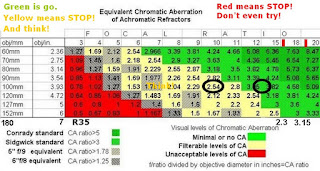*
With time to spare before dinner I went back out to do some start testing. It did not start well due to ribbed cloud. Orion was just west of south so I chose bright stars there to ensure I had enough light.
I started with the 32mm to find the stars and centre them with the paddle. Then I worked upwards in power and down in focal length. I added the 1.25" Baader Solar Continuum filter to each new eyepiece in the no-name 2" star diagonal. I started with Rigel but the cloud and thermal effects on the image made me up to Betelgeuse.
At focus the star was nicely small and intense with only a ring or two. Inside focus there was a mass of evenly bright rings and a fuzzier and brighter, outer ring. Outside focus was dimmer and showed thermal effects crossing the image rather like clouds. The image was much scruffier but occasionally showed a similar pattern to inside focus.
Eventually I ended up with the 10mm EP for 215x. This meant I had to stay closer to focus but the results were no particularly awful. Being similar to longer eyepieces but much more sensitive to focus.
The star images without the green filter were much messier as the chromatic aberration was no longer concealed. Reds and purples dominated depending whether I focused inside or outside focus. It also showed far more thermal agitation. Though it may be that the seeing was going due to a massive cloud bank appearing in the East.
I didn't have time to use my Ronchi "filter" with the green filter as I had planned. I had tried this some time ago but the forum experts seemed to be in disagreement with each other.
 While star testing is an interesting exercise it is not the same as have a "great" lens which shows fine detail on the moon or planets. Seeing permitting. I have tried stopping down the iStar with cardboard rings in the dewshield but the results were inconclusive. I always preferred the brightest image.
While star testing is an interesting exercise it is not the same as have a "great" lens which shows fine detail on the moon or planets. Seeing permitting. I have tried stopping down the iStar with cardboard rings in the dewshield but the results were inconclusive. I always preferred the brightest image.
 While star testing is an interesting exercise it is not the same as have a "great" lens which shows fine detail on the moon or planets. Seeing permitting. I have tried stopping down the iStar with cardboard rings in the dewshield but the results were inconclusive. I always preferred the brightest image.
While star testing is an interesting exercise it is not the same as have a "great" lens which shows fine detail on the moon or planets. Seeing permitting. I have tried stopping down the iStar with cardboard rings in the dewshield but the results were inconclusive. I always preferred the brightest image.
An interesting but probably inconclusive series of star tests. It needs much better seeing to stabilise the image. Particularly outside focus.
iStar claim 1/4 wave accuracy as their minimum standard. The reason for my testing was seeing a forum discussion on star testing another iStar objective. A 6" F/10. My 7" [180mm] is an f/12 R35. The R35 is supposed to suggest it performs as well as an f/16 normal achromat. Stopping my 7" down to a 6" would make it an f/14. Adding the 35% reduction in false colour would make it the equivalent of about f/19. Which puts it more safely in the green zone of allowable CA by Sidgwick standards. The yellow zone in the chart is supposed to represent where colour correction using minus-violet or "Fringe Killer" filters can help to improve matters to visually acceptable levels.
I keep wanting my 7" to show the small craters in Plato but still haven't succeeded. Where others have seen lots with far smaller apertures. Poor/unknown collimation has always been an issue until recently. So there is still a chance. The Orion Cheshire body is grossly undersized. So needs a compression band fitting to be used at all. Then there is always the issue of star diagonal alignment.
iStar claim 1/4 wave accuracy as their minimum standard. The reason for my testing was seeing a forum discussion on star testing another iStar objective. A 6" F/10. My 7" [180mm] is an f/12 R35. The R35 is supposed to suggest it performs as well as an f/16 normal achromat. Stopping my 7" down to a 6" would make it an f/14. Adding the 35% reduction in false colour would make it the equivalent of about f/19. Which puts it more safely in the green zone of allowable CA by Sidgwick standards. The yellow zone in the chart is supposed to represent where colour correction using minus-violet or "Fringe Killer" filters can help to improve matters to visually acceptable levels.
I keep wanting my 7" to show the small craters in Plato but still haven't succeeded. Where others have seen lots with far smaller apertures. Poor/unknown collimation has always been an issue until recently. So there is still a chance. The Orion Cheshire body is grossly undersized. So needs a compression band fitting to be used at all. Then there is always the issue of star diagonal alignment.
*
No comments:
Post a Comment